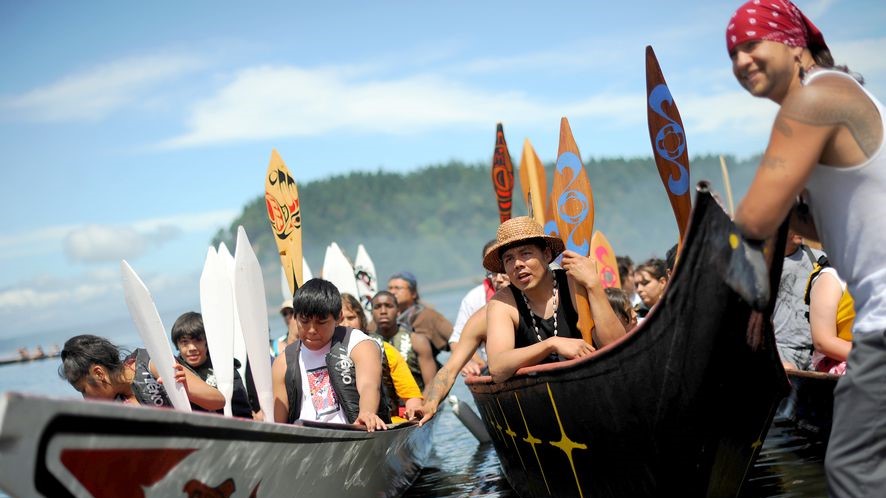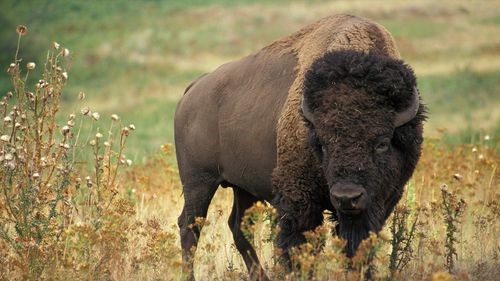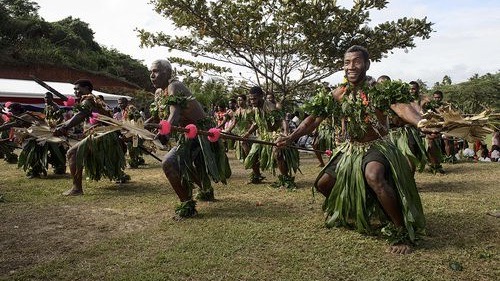Have you ever paddled a canoe? It can be hard work! A person needs strength, skill, and concentration to steer a canoe in the right direction. Long before steamboats, trains, and cars existed, canoes were one of the main ways that Native Americans traveled from place to place. In Canada and the northern United States, these boats were used to travel through creeks, streams, and rivers. They were also used for racing as a sport.
So what exactly is a canoe? Unlike a steamboat or a motorboat, a canoe is powered only by the strength of the people using it. There are many different styles of canoes. Most of them are flat-bottomed boats with two seats in them. The two people inside the canoe paddle to move the boat. They use oars with wide, flat paddles to push the canoe through the water.
The different styles of canoes developed by Native American tribes were influenced by the different environments where the canoes were made. Different canoes were also built to serve different purposes. For example, in the Pacific Northwest, tribes like the Tlingit and Chinook used huge cedar trees to make their canoes. These canoes were “dugout canoes.” This means that they were made by hollowing out a tree trunk. They were sometimes made for travel along the ocean coastline, and sometimes for travel through a river. The ocean canoes had thicker, deeper bottoms, while the river canoes were smaller and lighter. In the eastern woodlands of Canada, smaller canoes were commonly made by First Nations like the Ojibwe and Algonquin. These canoes were made from the bark of the birch tree. Boatbuilders would create a wooden frame for the canoe. Then, they would wrap the frame with birchbark and other natural materials. These lightweight canoes were easy to maneuver along rivers and streams.
Traditionally, Native Americans used these canoes for everything from travel and trade to hunting and fishing. But canoes were also used for racing. Canoes built for racing often had a different design than other canoes. For example, one popular racing canoe made by the Salish First Nation on Canada’s west coast can hold 11 people! These racing canoes are built long and narrow for speed. They can be up to 50 feet long!
Like the styles of different canoes, the traditional types of racing done in canoes varied from region to region. On the west coast, one Native racing tradition involved racing in the canoe to one specific spot. There, the crew would flip the canoe over. From the water, the crew of the canoe would have to flip it back, climb back in, get rid of any water inside, and finish the race. This kind of race was considered a show of boat handling skills and speed. Native people across the continent also participated in speed-focused races in canoes. For these kinds of races, athletes had to paddle as hard as they could. These races required teamwork with the other people in the boat. They also required strength and endurance. These kinds of races are still practiced today by Indigenous athletes.
Today, traditional canoe building is being embraced by Native American people. Traditional canoe building skills have been passed down through generations of boatbuilders. There are many programs around Canada dedicated to preserving these traditional methods of canoe building and bringing back traditional canoe routes.
Canoe racing is another way that Native Americans continue to embrace their traditions. At the North American Indigenous Games, or NAIG, Native American athletes compete in different sporting events. Canoe and kayak racing are hugely popular events. Hundreds of Native athletes from across North America participate in these races. Many of the athletes come from tribal communities where canoes are still used for hunting, fishing, and travel. For them, canoes are not just a way to connect with traditional Native American technology. Canoes are also a way to showcase their athletic skills and their pride in their roots.









